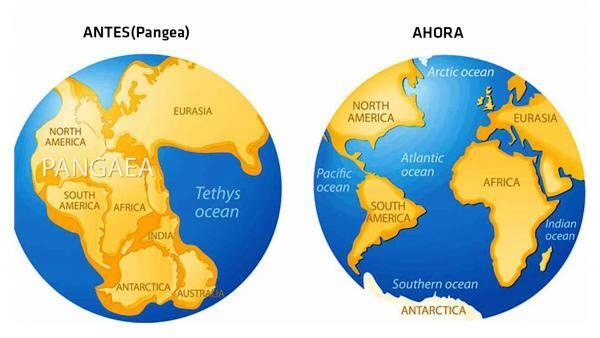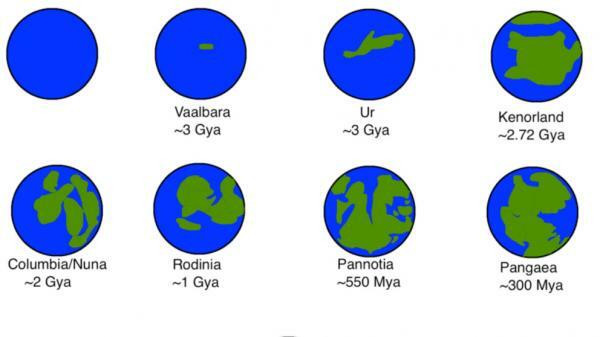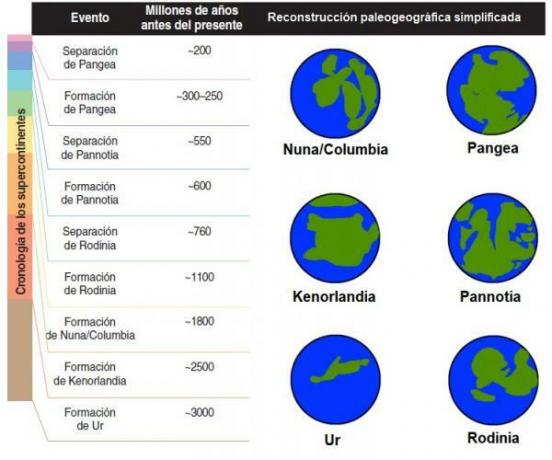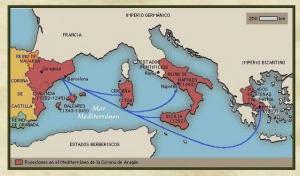Formation of the continents

Image: Class20
Our planet has not always been as we know it currently, there was a time millennia ago in which the formation of the continents was very different from the current terrestrial distribution. To know the evolution that our planet has had from the first land formations to that the entire terrestrial distribution became like the current one in this lesson from a PROFESSOR we offer you a summary of the formation of the continents so you know how the continents of the planet were created.
During the Archaic period of our planet, located more or less 4 billion years ago and 2.5 billion years, the heat of the earth's mantle was much warmer than the current one, causing volcanic activity much higher and creating plate tectonics at a speed much greater than we can understand in the present.
Is first earth's crust primitive never managed to form a lasting continent, since it is thought that its recycling was much greater, so the first so-called continentsThey could not form until the terrestrial mantle was somewhat colder.
The first protocontinents existing were very small compared to those who came later and, as we have said, their formation was still too hot, causing a greater evolution and speed, causing that neither large nor continents could be originated durable.
We must know that terrestrial rocks still exist of the first land formations, being located in the area where Canada and Greenland they approach, being the only memories that we have of the first attempts of terrestrial formation and therefore of the first protocontinents.

Image: Ok Diary
To continue with this lesson on the formation of the continents, we must talk about the formation of the so-called supercontinents, being the ones that would give way to what we currently know as continents.
We can say that the first supercontinent of our planet was Rodinia, being born 1100 million years ago and occupying most of the land area of the time. The origin of Rodinia took place in the so-called Proterozoic and its completion was 750 million years ago. This supercontinent was located in the area of Ecuador, and it is thought that its climate was very cold, with all its surface formed by glaciers, although it is unknown if it was their existence that caused these losses temperatures.
After millions of years Rodinia split into three, forming Proto-Laurasia, a craton of the Congo and Proto-Gondwana. Years later and due to the movements of the world, the Congo craton was located between the other two land masses, forming the supercontinent of Pannotia. This union took place during the Precambrian and it is considered that of one of the continents with greater glacier formation of the history of mankind.
This supercontinent did not survive long and did not take long to form the known Laurentia, Baltic, Siberia and Gondwana. These continents are very relevant, since a large part of the current continents are born from them, finding many of their elements today.
For a time these four continents were kept separate but over time the tectonic movement caused they will start to get together, being a slow process that lasted years. After this long process the four continents were united forming a single supercontinent, being the most recent of all and whose name was Pangea. The importance of Pangea It is huge, since it was from this supercontinent that the world we know was born.

Image: Geological Man
On Pangea we can see the origin of the current continents of our planet, being the reason why we must talk about this supercontinent to know the formation of the continents.
Pangea was a supercontinent whose origin dates back to late Paleozoic and that it separated at the beginning of the Mesozoic, so we can say that its union took place some 335 million years ago, and their separation to form the present continents was about 175 million years ago. years.
The Pangea separation It was a long-lasting period, taking millions of years to complete its separation, which is why experts have decided to divide the process into three breakdown phases. These phases are as follows:
- The first phase took place around the period known as Middle Jurassic. In this phase Pangea was moving away from the Tethys Ocean to the east and initiating a movement towards the Pacific Ocean in the west. On the other hand, two parts of Pangea began to separate, this separation being what would form America and Africa, and originating the Atlantic Ocean due to the separation between them. These movements also aided in the later creation of the Indian and Arctic.
- The second phase took place in the Cretaceous early and began with the separation of Gondwana, forming Africa, South America, India, Australia and Antarctica. In this phase, the separation between Africa and South America was greater and creating the distance that we know today. You could say that this phase is about the separation of continents creating oceans between them, increasing maritime separation.
- The third phase took place at the beginning of Mesozoic and it marked the separation of North America and Eurasia, giving rise to something similar to what we now call Europe, Asia and North America. All continents and land masses begin a slow process of separation that would lead to the current situation after years of movements, being a movement that still exists.

Image: Red Historia


![Summary of the KOSOVO war: causes and consequences [with MAP and VIDEO!]](/f/2b0211803c70b7ecaeab2464deb1767b.jpg?width=300&height=200)
